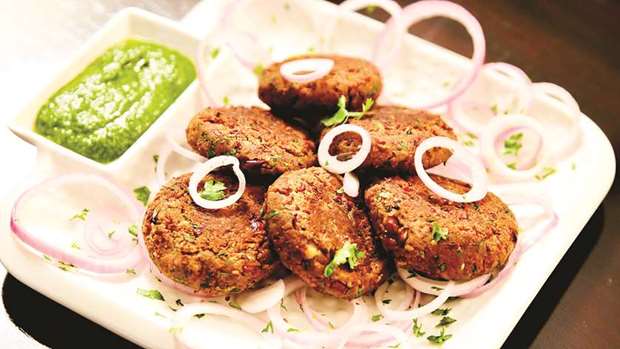Colocasia (Arbi) is a tropical plant grown primarily for its edible corms, the root vegetable is also known as taro. The Hindi name arvi/arbi may suggest a lay person connection with the Arab world. However colocasia is one of the oldest vegetables grown in the in Indian sub-continent. As a child, I always used to believe the origin of one of my favourite vegetables is Arab world due to its name. . It is believed to be one of the earliest cultivated plants. Taro commonly refers to the widely cultivated species of several plants which are used as vegetables for their corms, leaves and stalks.
Even before potato was widely used in the sub-continent’s kitchens, colocasia was the preferred tuber. Both its leaves and tuber/corm were used in cooking not just in north India but all over the country. I particularly like the corm and my mother used to make it in dry subzi and in curry style with turmeric. In north east regions, the leaves are chopped up and made into a curry. In western India, the leaves are coated with gram flour and crisp fried as a snack and in south India the tuber is fried and curried and then served with rice. Colocasia is not only exclusive to India but is popular in South East Asia too. In Philippines, it is known as “abi” and is a popular veggie.
The favoured way to cook the tuber is to fry it. Since colocasia is also a monsoon ingredient and the Indian kitchens were based on Ayurveda, which emphasised a switch to heat inducing foods gradually as the monsoon cooled the sub-continent and to fry foods to keep the diseases at bay. That is also perhaps why arbi and ajwain (caraway seeds) make or such a perfect marriage. Ajwain is known for its digestive properties. It makes perfect sense and a perfect recipe to use the monsoon spice warding off stomach infections common this time of the year is to batter fried Colocasia.
Even the leaves are crisp-fried as pakora in Uttar Pradesh, Bihar and Gujarat by sprinkling gram flour and ajwain. Pakora is a perfect recipe for monsoon. Colocasia leaves are cleaned and washed and then coated with a thin layer of besan (gram four). The leaves can be layered, folded and then rolled. They are then cut into rounds and deep fried for a teatime snack. You may not find more exotic pakora anywhere else.
The vegetable is an invaluable source of dietary fibre. The corms have more calories than potato and these come primarily from complex carbs, which are slow digesting, will thus help you fill up more and also help elevate blood sugar levels gradually with easy to break down carbs. The leaves on the other hand have antioxidants, beta carotene and a significant amount of vitamin A that is good for your eyesight amongst other things. And the corm has some essential minerals as well- Zinc, magnesium and potassium that helps regulate heart rate and blood pressure. So what you thought was an empty tuber is actually quite a superfood in its own right.
In the last few years I have also seen and experienced the resurgence of tubers, other than potatoes as a favourite ingredient in Kitchens. Even though staples like colocasia, tapioca and yams have been staples, almost regarded as everyman’s source for dietary fiber and nutrition, chef’s experimenting with local ingredients and veggies have resulted in these tubes being highlighted in chic menus like never before.
Cassava chips, as you may have noticed are quite popular and trendy on the menus at bars and cafés. What began as a South American craze, seems to have permeated into pop food culture and the chips have been replacing those mighty potato wedges and the chips on the strength of their unquestionable nutritional superiority.
Fascinatingly, it seems as though every culture uses this veggie in a slightly different way, depending on how it is prepared and the variety of the crop that is grown. It is also one of the few crops that can grow in the flooded areas, due to its petioles, which can transfer materials even while underwater. It is a staple food in African, Indian, and oceanic cuisine, but it can be found everywhere from Japan, Egypt, Fiji and Spain.
In Punjabi influenced cooking, arbi may of course be cooked in a generic onion, tomato masala. But its charm can be better appreciated if you use the spices selectively. Dried fenugreek is another ingredient that blends well with colocasia. Pan roast the veggie and then coat it with a masala that includes some kasoori methi and I am sure the flavor will mesmerise you. Today I will share an uncommon recipe of kebabs made with colocasia. I came across this recipe almost 15 years back in New Delhi and I still rember the taste and tender texture of the kebab.
Arbi Oatmeal Kebab
Ingredients
Colocasia 750 gm
Caraway seeds ½ tsp
Cumin seeds ½ tsp
Ginger, chopped ½ tbsp
Fresh mint leaves few sprigs
Salt to taste
Roasted Chana dal powder 4 tbsp
Potato, boiled 1 no
Chat masala 1 tsp
Coriander leaves, chopped 1 tbsp
White oats 2 cup
Oil to shallow fry
Garnish
Onion rings to garnish
Bell pepper, juliennes to garnish
Accompaniments
Lemon wedge
Mint chutney
Method
Heat water in a heavy bottom pan and add colocasia and boil till soft
Cool, peel and mash the Colocasia with a wok and keep aside in a bowl
Dry roast cumin and caraway seeds till fragrant and add to the mashed colocasia
Add chopped ginger, green chili, salt, coriander leaves, boiled mashed potato, roasted chana dal powder and mix well to combine
With oil greased hands make into small patties and keep them aside
Pat the patties into white oats and repeat for all the other patties, refrigerate for 30 minutes
Heat 4 tbsp oil in a non stick pan and shallow fry the prepared patties from both sides until golden brown and crispy
Remove on a kitchen paper towel to remove excess oil
Serve hot sprinkled with chat masala and onion rings, bell pepper and lemon wedge on side.
* Chef Tarun Kapoor,
Culinary Mastermind, USA. He may be contacted at [email protected]

UNCOMMON: Taste and tender texture of Arbi Oatmeal Kebab are unforgettable.tPhoto by the author


